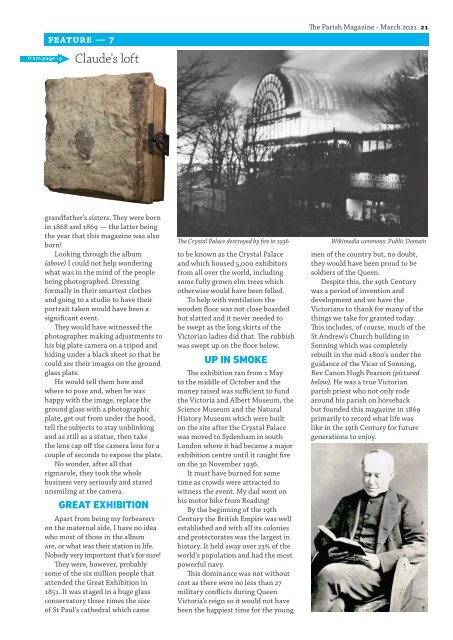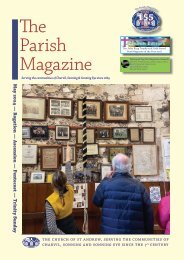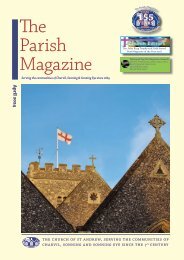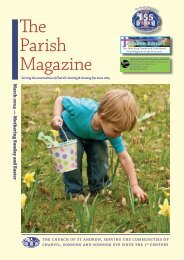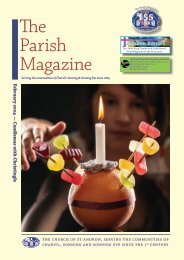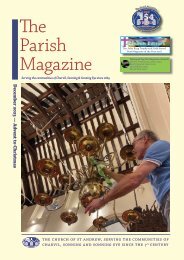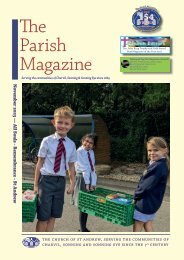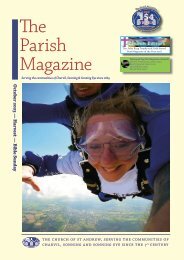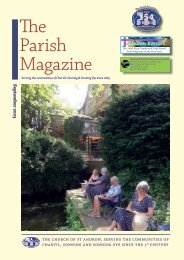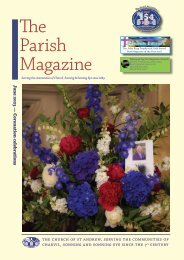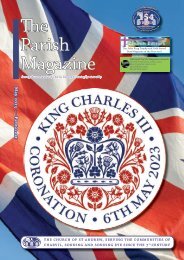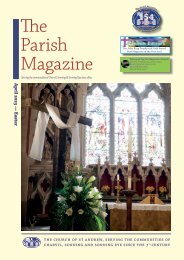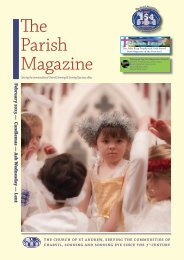The Parish Magazine March 2021
Serving the communities of Charvil, Sonning and Sonning Eye since 1869
Serving the communities of Charvil, Sonning and Sonning Eye since 1869
Create successful ePaper yourself
Turn your PDF publications into a flip-book with our unique Google optimized e-Paper software.
from page 19<br />
feature — 7<br />
Claude's loft<br />
<strong>The</strong> <strong>Parish</strong> <strong>Magazine</strong> - <strong>March</strong> <strong>2021</strong> 21<br />
grandfather’s sisters. <strong>The</strong>y were born<br />
in 1868 and 1869 — the latter being<br />
the year that this magazine was also<br />
born!<br />
Looking through the album<br />
(above) I could not help wondering<br />
what was in the mind of the people<br />
being photographed. Dressing<br />
formally in their smartest clothes<br />
and going to a studio to have their<br />
portrait taken would have been a<br />
significant event.<br />
<strong>The</strong>y would have witnessed the<br />
photographer making adjustments to<br />
his big plate camera on a tripod and<br />
hiding under a black sheet so that he<br />
could see their images on the ground<br />
glass plate.<br />
He would tell them how and<br />
where to pose and, when he was<br />
happy with the image, replace the<br />
ground glass with a photographic<br />
plate, get out from under the hood,<br />
tell the subjects to stay unblinking<br />
and as still as a statue, then take<br />
the lens cap off the camera lens for a<br />
couple of seconds to expose the plate.<br />
No wonder, after all that<br />
rigmarole, they took the whole<br />
business very seriously and stared<br />
unsmiling at the camera.<br />
GREAT EXHIBITION<br />
Apart from being my forbearers<br />
on the maternal side, I have no idea<br />
who most of those in the album<br />
are, or what was their station in life.<br />
Nobody very important that’s for sure!<br />
<strong>The</strong>y were, however, probably<br />
some of the six million people that<br />
attended the Great Exhibition in<br />
1851. It was staged in a huge glass<br />
conservatory three times the size<br />
of St Paul’s cathedral which came<br />
<strong>The</strong> Crystal Palace destroyed by fire in 1936<br />
to be known as the Crystal Palace<br />
and which housed 5,000 exhibitors<br />
from all over the world, including<br />
some fully grown elm trees which<br />
otherwise would have been felled.<br />
To help with ventilation the<br />
wooden floor was not close boarded<br />
but slatted and it never needed to<br />
be swept as the long skirts of the<br />
Victorian ladies did that. <strong>The</strong> rubbish<br />
was swept up on the floor below.<br />
UP IN SMOKE<br />
<strong>The</strong> exhibition ran from 1 May<br />
to the middle of October and the<br />
money raised was sufficient to fund<br />
the Victoria and Albert Museum, the<br />
Science Museum and the Natural<br />
History Museum which were built<br />
on the site after the Crystal Palace<br />
was moved to Sydenham in south<br />
London where it had became a major<br />
exhibition centre until it caught fire<br />
on the 30 November 1936.<br />
It must have burned for some<br />
time as crowds were attracted to<br />
witness the event. My dad went on<br />
his motor bike from Reading!<br />
By the beginning of the 19th<br />
Century the British Empire was well<br />
established and with all its colonies<br />
and protectorates was the largest in<br />
history. It held sway over 23% of the<br />
world's population and had the most<br />
powerful navy.<br />
This dominance was not without<br />
cost as there were no less than 27<br />
military conflicts during Queen<br />
Victoria’s reign so it would not have<br />
been the happiest time for the young<br />
Wikimedia commons: Public Domain<br />
men of the country but, no doubt,<br />
they would have been proud to be<br />
soldiers of the Queen.<br />
Despite this, the 19th Century<br />
was a period of invention and<br />
development and we have the<br />
Victorians to thank for many of the<br />
things we take for granted today.<br />
This includes, of course, much of the<br />
St Andrew's Church building in<br />
Sonning which was completely<br />
rebuilt in the mid-1800's under the<br />
guidance of the Vicar of Sonning,<br />
Rev Canon Hugh Pearson (pictured<br />
below). He was a true Victorian<br />
parish priest who not only rode<br />
around his parish on horseback<br />
but founded this magazine in 1869<br />
primarily to record what life was<br />
like in the 19th Century for future<br />
generations to enjoy.


